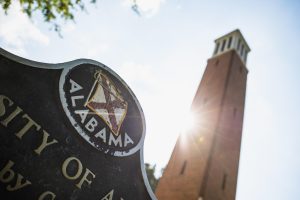Slavery commission to study historical racism
November 8, 2018
As a black student at The University of Alabama, Morgan Miller has had her share of racially-charged incidents on campus. One incident in particular took place her freshman year.
“Me and my roommates, we are all black, we were going down frat row and this one frat were yelling racial slurs from the second-floor balcony,” said Miller, a sophomore majoring in management information systems.
Race is no new issue on campus. To Anna Beth Peters, The University of Alabama could work harder to uncover its long-standing history with race.
“There’s a lot we don’t know about Alabama, and no one really tries to uncover it,” said Peters, a sophomore majoring in political science and communication studies. “We know that there’s a lot of racial tension at the University and there always has been, but I feel like the University could do a lot better of a job handling it and exposing it and moving forward in the future.”
The University took a step toward recognizing its past at its most recent Faculty Senate meeting.
At the meeting, the senate voted on issues regarding inclusion like placing a menorah next to the holiday tree display on the Rose Administration Building lawn, evening and weekend parking passes and the creation of the commission on race, civil rights and slavery at the University.
Kevin Whitaker, UA executive vice president and provost, said in an email that the University has received the resolutions and is discussing them with the Senate.
The commission was proposed intending to create a dialogue on campus about race and its history.
“When new prospective students are brought to campus and are given the tour of campus, they show you the President’s Mansion, and what they don’t tell you is that what is typically described if anyone asks as the ‘gardeners’ homes that are behind the president’s mansion,’ they’re actually slave quarters,” said Rona Donahoe, UA Faculty Senate president.
According to Alabama NewsCenter, Gov. George Wallace famously opposed the integration of The University of Alabama in 1963 in the “Stand in the Schoolhouse Door” incident at Foster Auditorium on campus.
“That part of our history gets glossed over and sort of fallen by the wayside, and unless we keep that type of information in the forefront, we’re going to forget it,” Donahoe said. “The idea is that this commission would be able to keep that historical memory alive about the history of slavery on campus. The campus did make use of slaves, and there’s a lot of interesting history, where one of our first presidents of The University of Alabama, he did not own slaves himself, but he rented slaves from another faculty member.”
The Faculty Senate stated in the proposal that possible members of said commission could include, but are not limited to, Faculty Senate representatives, UA Museums and Libraries representatives, Black Faculty and Staff Association representatives, the vice president and associate provost for diversity, equity and inclusion and the Division of Student Life.
Donahoe said one of the University’s first steps is to join a national consortium with institutions dealing with exactly the same topic, called Universities Studying Slavery. She said The University of Virginia and other universities in the Southeast are members of it, and they have national meetings and talks where people share information about their campus.
Peters is also a student in Hilary Green’s class called Slavery, Emancipation, and The University of Alabama. The class is creating a pop-up museum to show what slaves went through after emancipation.
“There’s not a lot of research on what happened in Tuscaloosa and at the University after emancipation was granted to all the slaves that worked here,” Peters said. “A lot of people were like, ‘Oh, the slaves are free, they’re good now,’ but it really wasn’t. There was still so much struggle and so much violence that went on here, and that’s what our pop-up museum is detailing.”
The exhibition, taking place Nov. 29 from 5:30 to 7 p.m. in 205 Gorgas Library, will explore the lives and experiences of the black community in Tuscaloosa after the Civil War, from 1865 to 1890.
Outside of the classroom, Green gives a walking tour on campus called “Hallowed Grounds: Race, Slavery, and the University.”
“We talk a lot about slavery and by talking about slavery we keep people enslaved and treated as property, I’d rather see what happens when they’re no longer property and they actually have a say to control their lives,” said Green, associate professor at the University.
This is not the first time the UA Faculty Senate has recognized the University’s relation to slavery. According to The Tuscaloosa News, the Faculty Senate passed a resolution to formally apologize for slavery 14 years ago.
“There is a long and not always rosy history of race and race relationships on campus that should be a part of the overall context of civil rights in the United States,” Donahoe said.
Miller said the University can always do more to recognize its history with black people on this campus.
“Last year they made a plaque for the first black lady to attend Alabama, but all these buildings named after these white men, and she just got a plaque?” Miller said. “They could have acknowledged her better than what they did.”
Editor’s note: Anna Beth Peters is a staff columnist for The Crimson White.





















